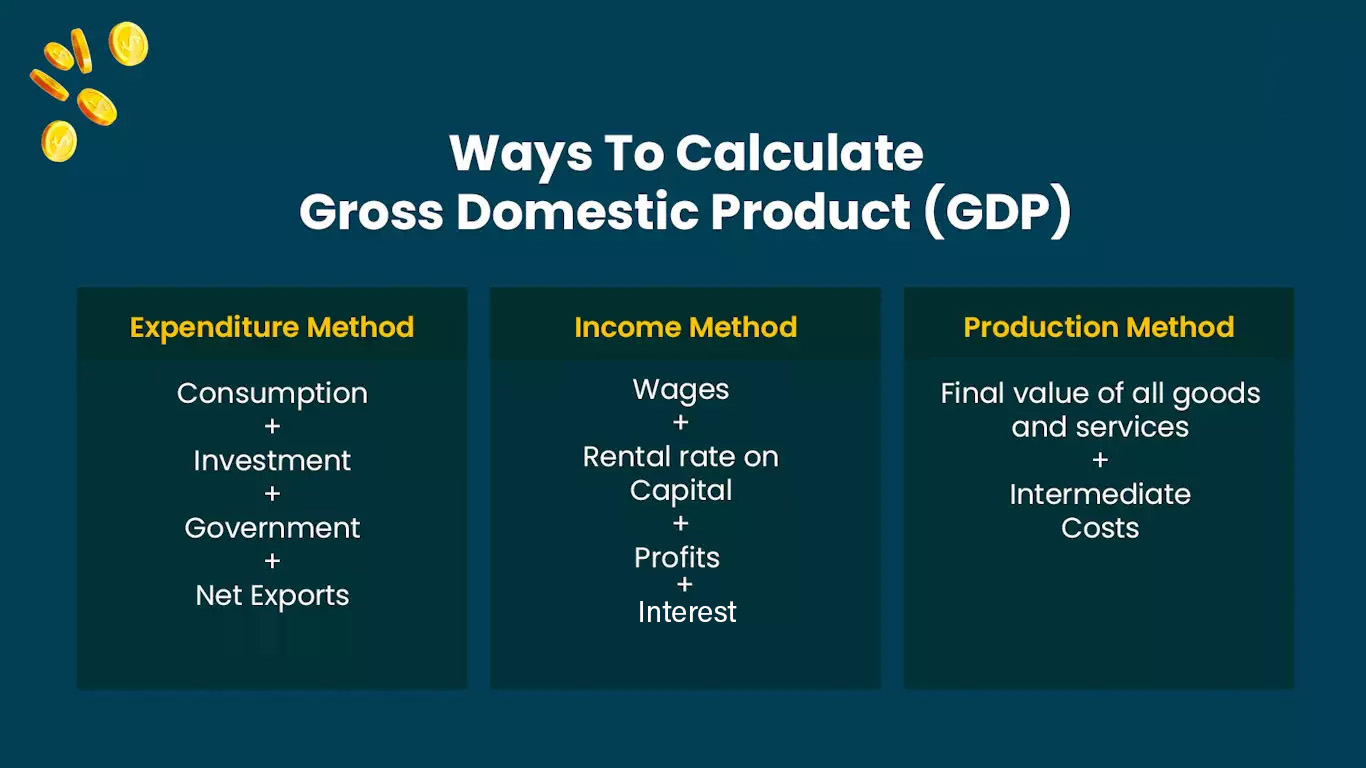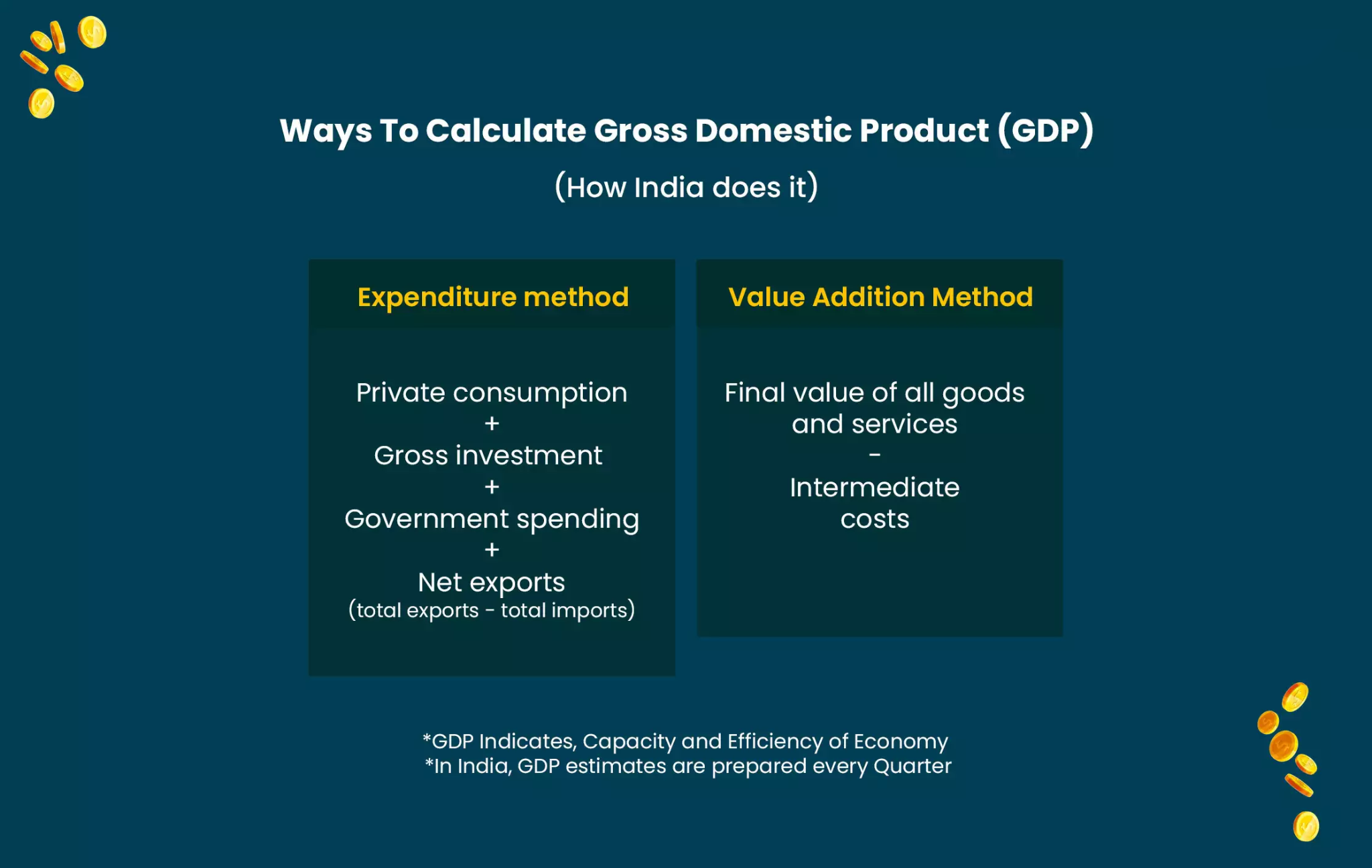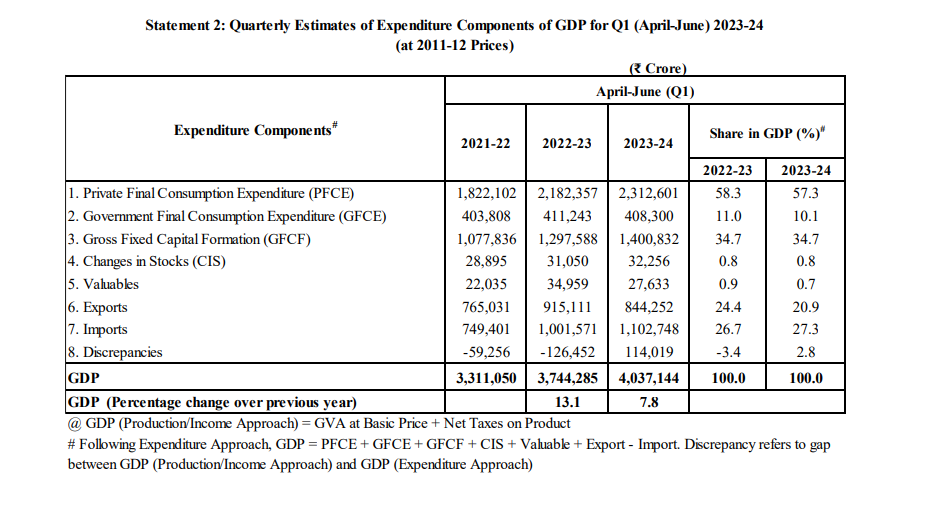Indian Economy
Concerns Related to India’s GDP Data
- 26 Sep 2023
- 10 min read
For Prelims: GDP (Gross Domestic Product), Gross Fixed Capital Formation, Purchasing Managers’ Indices, Bank Credit Growth, Index of Industrial Production (IIP).
For Mains: Concerns Related to India’s GDP Data, Calculations Methods For GDP in India.
Why in the News?
Recently, the Ministry of Finance has addressed concerns regarding the credibility of Indian GDP (Gross Domestic Product) data, particularly in light of a 7.8% increase in the first quarter of FY 2023-24.
- Several experts have pointed out discrepancy in India’s GDP statistics, which present a positive image of economic growth on billboards, while underlying issues such as rising inequalities, job scarcity, and a decline in manufacturing jobs persist.
What are the Concerns Raised with Respect to GDP Numbers?
- Discrepancies in GDP Calculation:
- An analysis of the GDP expenditure components reveals a concerning trend where most elements have decreased as a percentage of GDP.
- This includes private consumption, government spending, valuables, and exports.
- Imports have slightly increased, while Gross Fixed Capital Formation (investment in assets) and Change in Stocks (inventory changes) have remained stable.
- Therefore, there is an unexplained gap in the GDP calculation, which raises questions about the accuracy of the reported economic data.
- An analysis of the GDP expenditure components reveals a concerning trend where most elements have decreased as a percentage of GDP.
- Dual GDP Calculation Methods:
- India's GDP is calculated using two distinct methods: Economic activity (at factor cost) and Expenditure (at market prices).
- The factor cost method assesses the performance of eight different industries. The following eight industry sectors are considered in this cost:
- Agriculture, forestry, and fishing,
- Mining and quarrying,
- Manufacturing,
- Electricity, gas, water supply, and other utility services,
- Construction,
- Trade, hotels, transport, communication, and broadcasting,
- Financial, real estate, and professional services,
- Public administration, defense, and other services
- The expenditure-based method indicates how different areas of the economy are performing, such as trade, investments, and personal consumption.
- The factor cost method assesses the performance of eight different industries. The following eight industry sectors are considered in this cost:
- The differences between these methods may lead to variations in GDP figures.
- India's GDP is calculated using two distinct methods: Economic activity (at factor cost) and Expenditure (at market prices).
- Impact on Public Perception:
- Experts express concern that presenting an overly positive image of economic growth through GDP figures can mask the economic struggles and challenges faced by a significant portion of the population.
- This can impact public perception and policy decisions.
- Outdated Data Sets and Delayed Census:
- One of the major concerns is the usage of outdated data sets in the calculation of GDP, which may not accurately reflect the current economic scenario.
- Additionally, delays in conducting the census contribute to potential inaccuracies in economic assessments.
- There are concerns that the methods employed may not effectively capture the complex and evolving economic landscape, leading to potentially skewed GDP figures.
- Allegations of Government Interference:
- Allegations of government interference in the calculation and release of GDP figures have surfaced.
- Experts worry that political motivations might influence the presentation of economic data, impacting its accuracy and reliability.
How Has the Government Addressed the Issues Raised by the Experts?
- Credibility of Indian GDP Data:
- The Finance Ministry refuted doubts about the credibility of Indian GDP data, clarifying that it is not seasonally adjusted and is finalized three years later.
- This implies that relying solely on GDP indicators to assess underlying economic activity is misleading.
- Need for Comprehensive Analysis:
- The Ministry urged critics to consider various growth indicators, such as Purchasing Managers’ Indices, Bank Credit Growth, and consumption patterns, to form a well-rounded view of the economic activity.
- Underestimation of Growth Numbers:
- The Ministry argued that India's growth numbers might actually underestimate the economic reality, citing the Index of Industrial Production (IIP) as an example where reported manufacturing growth is lower than what companies are indicating.
- Nominal vs. Real GDP Growth:
- Addressing concerns about nominal GDP growth being lower than real GDP growth, the Ministry explained that India's GDP deflator, dominated by the Wholesale Price Index (WPI), is affected by various factors and will normalize in the coming months.
- Income Approach for GDP Calculation:
- The Ministry highlighted that India consistently uses the Income Approach for calculating GDP growth and does not switch between approaches based on favorability, dismissing arguments that favor nominal GDP growth.
What is GDP?
- About:
- GDP is the gross valuation of all the goods and services generated within a country's borders for a specific period, typically one financial year.
- One can identify a country's development and economic progress from its GDP.
- The percentage growth of GDP over a quarter is taken as a standard growth of the economy.
- As per the reports by International Monetary Fund (IMF), India is among the top 10 countries in the world based on the nominal GDP in 2023.
- GDP is the gross valuation of all the goods and services generated within a country's borders for a specific period, typically one financial year.
- Types of GDP:
- Real GDP:
- Real GDP is measured with respect to a base year. It is adjusted to inflation and hence is also known as inflation-corrected GDP or current price.
- For example, the base year for calculating India's Real GDP is 2011- 12. Earlier, it used to be 2004- 05.
- It is considered to be a more precise representation of GDP as it considers the actual income of individual residents after adjusting to the price fixed for a base year.
- Real GDP is measured with respect to a base year. It is adjusted to inflation and hence is also known as inflation-corrected GDP or current price.
- Nominal GDP:
- Nominal GDP is assessed using prevailing market prices and does not consider inflation or deflation.
- From the government's perspective, Nominal GDP is a more accurate reflection of economic growth as it affects the citizens directly.
- Real GDP:
- Calculation of GDP:
- Expenditure Method: This approach takes into consideration the total expenditure incurred by all individuals in one economy for Goods and Services.
- GDP (as per expenditure method) = C + I + G + (X-IM)
- where, C: Consumption expenditure, I: Investment expenditure, G: Government spending and (X-IM): Exports minus imports, that is, net exports.
- Output Method: This approach is used to determine the market value of all the services and products produced within a country.
- This method helps eliminate any difference in GDP measurement due to price level fluctuations.
- Income Method: This approach considers the gross income earned by various factors of production, like capital and labour, within the boundaries of a country.
- This is a sum of expenditure made by companies on their workforce.
- GDP calculated based on this approach is known as GDI or Gross Domestic Income.
- GDP ( through Income Method) = Wages + Rent + Interest + Profit
- Expenditure Method: This approach takes into consideration the total expenditure incurred by all individuals in one economy for Goods and Services.
 |
 |
What Are the Limitations Of GDP?
- GDP does not include non-market transactions that positively impact productivity, such as domestic, voluntary, or other participations. Also, it doesn't take into account goods produced for private consumption.
- India is one of those countries where unequal income distribution is a prime discrepancy in its economy. GDP doesn’t reflect that.
- One cannot determine the standard of living of a country from its GDP.
- India is the best example of it. It has a high GDP but a relatively low standard of living.
- Most importantly, GDP doesn't reflect how industries affect the environment and social well-being.
- The government launched Green Gross Domestic Product (Green GDP) to address this issue.
Conclusion
- The Ministry of Finance emphasized the importance of considering various economic indicators and higher frequency data to form a comprehensive view of economic activity.
- It urged critics to refrain from selectively using data and maintain a nuanced understanding of the Indian economy.
UPSC Civil Services Examination, Previous Year Questions (PYQs)
Q. With reference to Indian economy, consider the following statements: (2015)
- The rate of growth of Real Gross Domestic Product has steadily increased in the last decade.
- The Gross Domestic Product at market prices (in rupees) has steadily increased in the last decade.
Which of the statements given above is/are correct?
(a) 1 only
(b) 2 only
(c) Both 1 and 2
(d) Neither 1 nor 2
Ans: (b)







